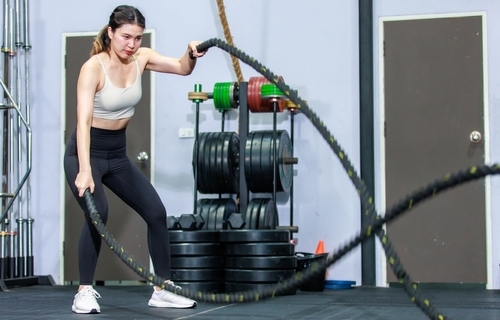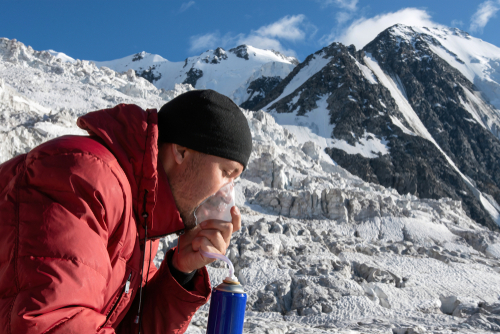Sandakphu-Phalut Trek is one of the most iconic treks in the Himalayan region, traversing the border area of Nepal and the Indian state of West Bengal. The trek offers breathtaking views of the Kanchenjunga range and other famous peaks. However, trekking at such an altitude requires proper preparation and fitness. This blog post will delve into the necessary considerations for ensuring an enjoyable and safe trek.
Fitness Requirements
Cardiovascular Fitness:
High-altitude winter treks present a unique set of challenges, combining the difficulty of altitude with cold temperatures and often unpredictable weather conditions. Cardiovascular exercise is not merely an optional component but a necessity in preparing for the Sandakphu-Phalut trek.
A regimen of at least 4-5 times a week for two months prior to the trek is recommended.
The following exercises are excellent choices, and incorporating a variety of them can offer a well-rounded training regimen:
Running
- Long-Distance Running: Builds endurance and stamina.
- Hill Running: Simulates the inclines you might face on the trek and builds leg strength.
Cycling
- Road Cycling: Improves cardiovascular fitness and leg strength.
- Mountain Biking: Offers a more challenging workout and simulates uneven terrain.
Swimming
Great for overall cardiovascular conditioning without stressing the joints.
Hiking
- Hiking with a Weighted Backpack: Mimics the actual trekking experience.
- Stair Climbing with a Backpack: Simulates steep ascents.
Cross-Training
Combining various exercises helps prevent boredom and targets different aspects of fitness.

High-Intensity Interval Training (HIIT)
Short, intense bursts of exercise followed by rest or lower-intensity periods. Excellent for boosting cardiovascular efficiency.

Strength Training:
The Sandakphu-Phalut Trek will require not only cardiovascular fitness but also substantial strength, particularly in the legs, core, and upper body. Strength training exercises targeting these areas will help in enhancing stability, reducing fatigue, and improving overall performance. Here’s a list of essential strength training exercises to prepare for high-altitude winter treks:
Leg Strength
- Squats such as Bodyweight Squats, Goblet Squats, and Back Squats help build overall leg strength, particularly the quadriceps and glutes.
- Lunges: Targets the thighs and glutes and improves balance.
- Leg Press: Focuses on quadriceps, hamstrings, and glutes.
- Calf Raises: Strengthens the calf muscles, vital for stability on uneven terrain.

Core Strength
- Planks: Standard as well as Side Plank helps build core stability and strength
- Russian Twists are instrumental in building balance and stability by targeting the obliques

Upper Body Strength
- Push-Ups help strengthen the chest, shoulders, and triceps.
- Pull-Ups target the back and biceps, essential for carrying a backpack.
- Dumbbell Rows help in building back strength
- Shoulder Press helps strengthen the shoulders, aiding in carrying loads.

Back and Lower Back Strength
- Deadlifts help build overall back strength, something that is critical for supporting heavy
- Back Extensions aid in posture and stability improvement by strengthening the lower back

PS: Undertaking smaller treks or long walks with a backpack can prepare your body for the real experience. We at TrekNomads usually undertake such practice treks for the difficult winter treks like EBC and ACT. However, if you’d want to join them for Sandakphu-Phalut too, feel free to get in touch.
Nutrition and Hydration
It is usually said that you are what you eat. It doesn’t mean that you become a chicken if you eat chicken, but it means that if you eat healthy, you’ll be healthy. Nutrition is very important for your overall well being, especially when it comes to engaging in strenuous activities like trekking. So, we have listed down some important bits about the kind of nutrition that you would need before the trek i.e. during the preparation phase and while trekking too.

Before the Trek
- Include all Macronutrients: Carbohydrates, proteins, and fats should be well-balanced in daily meals.
- Carbohydrate Loading: Increase carbohydrate intake a few days before the trek for added energy reserves.
- Make your body get used to drinking water. It shouldn’t happen that the minute you drink you need to rush to the loo.
- Avoid Alcohol and Caffeine, preferably two-three months before the trek
- Iron and Vitamin C support oxygen transport and can be beneficial at high altitudes so make sure you take the supplements
During the Trek
It is important for us to mention here that we at TrekNomads ensure a good, balanced nutritious diet for you all on the trek. However, you will come with your own habits and may choose to go one way or the other. Hence, listing down the points for a ready reckoner
- Small, Frequent Meals help you maintain energy levels throughout the day. So, instead of eating heavy once, take small portions whenever you feel hungry.
- Carry trail mix, nuts, energy bars, and dried fruits as these are high energy snacks providing quick energy and also easy to digest
- Even if you don’t feel thirsty, continue to hydrate. Just take a sip or two every now and then
- We serve some piping hot protein rich dishes in the food and make sure you eat the dal/rajma being served because proteins help in muscle repair and recovery.
- Avoid fats if you can- actually please do avoid them!
- High altitudes may suppress appetite, so consciously make an effort to eat.
Health Precautions
High-altitude trekking can be demanding, and certain health conditions may pose serious risks. Comprehensive health evaluations and necessary tests, guided by healthcare professionals, are essential in determining an individual’s suitability for such a trek. Listed below are some major health concerns, the patients of which should avoid high altitude winter treks like the Sandakphu-Phalut trek. We have also shared a list of probable tests that will help you figure out your default readiness for the Sandakphu trek.
- Heart Conditions: Individuals with heart diseases may struggle with lower oxygen levels and increased physical exertion at high altitudes.
- Respiratory Disorders: Conditions like asthma or chronic bronchitis can be exacerbated at high altitudes.
- High Blood Pressure Concerns: Uncontrolled hypertension can lead to complications at high altitudes.
- Diabetes: Managing blood sugar levels can be more challenging during a trek.

Pre-Trekking Tests
- Comprehensive Physical Examination that includes assessment of overall health, vital signs, and any underlying chronic conditions.
- Cardiac Stress Test for evaluating heart function and determining cardiovascular fitness.
- Pulmonary Function Test for assessing lung capacity and function.
- Blood Test to check for the Complete blood count, electrolytes, glucose levels, and other relevant parameters.
- Vision and Hearing Tests for ensuring that essential sensory functions are in good condition.
Understanding the Altitude
The Sandakphu-Phalut trek ranges from about 1,400 m at Mane Bhanjang to approximately 3,636 m at Sandakphu, and it goes even higher to Phalut at 3,600 m.
The first and foremost consequence of trekking to such heights is Altitude Sickness. Now, it may not happen too if you take the necessary precautions, however, it is always a good idea to know the symptoms and the possible remedies.
Understanding Altitude Sickness
Causes
Altitude sickness is caused by reduced air pressure and lower oxygen levels at high altitudes. When ascending to heights above 2,500 m, the body may not have enough time to adapt to the decreased oxygen, leading to symptoms of AMS.
Types of Altitude Sickness
- Mild Altitude Sickness (AMS): General discomfort, headache, nausea.
- High Altitude Cerebral Edema (HACE): A more severe form affecting the brain.
- High Altitude Pulmonary Edema (HAPE): Affects the lungs and can be life-threatening.

Symptoms
Symptoms can vary in intensity and usually appear within hours of reaching a high altitude. The major symptoms include:
- Headache
- Dizziness
- Nausea and vomiting
- Fatigue
- Shortness of breath
- Difficulty sleeping
Prevention and Management
Not a lot of effort is needed in the prevention of altitude sickness. You just have to stick to the few basics mentioned below:
- Climb Slowly: Ascending slowly allows the body to acclimatize to the decreased oxygen levels.
- Acclimatization Stops: Spending a day or two at intermediate elevations can be beneficial.
- Stay Hydrated: Drink Water Regularly as adequate hydration mitigates the symptoms.
- Avoid Alcohol and Caffeine: These substances can exacerbate dehydration and hence it is best to avoid them on high altitudes.
Medication
- Consult a Healthcare Professional: Medicines like Acetazolamide (Diamox) may be prescribed for prevention.
- Carry Basic Medications: Over-the-counter medications for headaches and nausea may be useful. It is important to note here that we at TrekNomads carry all the necessary medications, however, it is always a good idea to have your own first aid box too.
Nutrition
- Eat Carbohydrate-rich Foods: They facilitate oxygen metabolism.
- Avoid Heavy Meals: Simple, easily digestible foods are preferable.
Rest and Sleep
- Adequate Rest: Proper rest before and during the ascent can help the body adapt.
- Sleep at Lower Altitudes: If possible, climb high but sleep low.
Conclusion
The Sandakphu-Phalut Trek is undoubtedly a rewarding experience, but it requires careful preparation. Fitness training, acclimatization, proper nutrition, and equipment are crucial components in preparing for this high-altitude trek. With the right planning and adherence to guidelines, trekkers can enjoy the scenic beauty and unique cultural experiences that this trek has to offer. It’s an adventure that promises to be both challenging and fulfilling, something every trekking enthusiast should aspire to achieve.
FAQs about the Sandakphu-Phalut Trek
Q1: Where is the Sandakphu-Phalut Trek located?
A1: The trek is located along the border between Nepal and the Indian state of West Bengal. It passes through the Singalila National Park.
Q2: What is the difficulty level of the Sandakphu-Phalut Trek?
A2: The trek is considered moderate to challenging. While not extremely difficult, proper preparation and physical fitness are necessary due to trek distance and altitude.
Q3: What is the best time to undertake the Sandakphu-Phalut Trek?
A3: The trek can be done in two main seasons: Spring (March to May) when the rhododendrons are in full bloom, and Autumn (October to November) when the skies are clear for mountain views.
Q4: How long does the trek typically take?
A4: The Sandakphu-Phalut Trek typically takes about 8 to 10 days to complete, depending on whether you go for the Sandakphu short trek or the longer Sandakphu-Phalut trek.
Q5: Can I see Mt. Everest from the trek?
A5: Yes, one of the highlights of the trek is the panoramic view of the Himalayan range, including Mt. Everest, Lhotse, Makalu, and Kangchenjunga.
